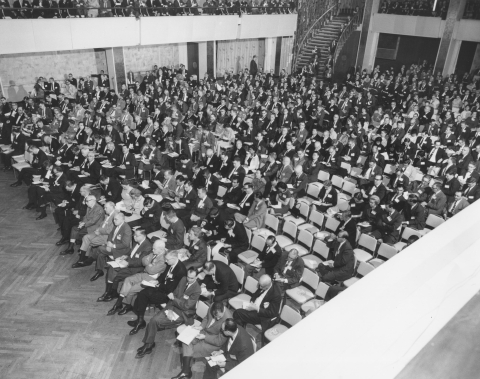Family is Key at the AAP Experience

In July of 1929, a group of pediatricians gathered over dinner in Portland, Ore., and decided to fill a need to improve child health and welfare. At the time, infant mortality rates were extremely high, and there was a lack of programs to avoid malnutrition and preventable childhood diseases.
Dr. Clifford G. Grulee, MD, from the Chicago area was chosen to lead the initiative. In December of that year, a committee drafted an outline for the new society.
That June, 35 pediatricians gathered at Harper Hospital in Detroit for the founding meeting of the American Academy of Pediatrics (AAP). About 400 pediatricians were invited to become charter members.
The AAP was officially incorporated in July 1930 in Illinois and the headquarters was set up in Dr. Grulee’s hometown of Evanston. The first AAP Annual Meeting was held in Atlantic City in June 1931, with 93 members attending, at least three of whom were women.
Ever since an exhibition was added to the Annual Meeting, the focus has been on the educational value of the exhibits. Exhibitor-sponsored Product Theaters are a popular element on the show floor.
Because the AAP focuses on pediatrics, the event reflects that mission by including families in the agenda to create an educational experience. Children are occasionally seen on the show floor, interacting with exhibitors and their products. The AAP Experience name officially was adopted in 2008.
In addition to adult receptions, there’s also one for children and families: AAP Kids’ Camp. Each year has a different theme, and this October it will be based on Dr. Seuss and will feature healthy food, music, games, crafts and more. There’s also a family-friendly offsite event each year in a local venue, museum, or attraction. This year will highlight an evening at the Exploratorium learning laboratory in San Francisco.
At the 2015 event in Washington, D.C., attendees and their families teamed up for AAP’s first-ever Urban Scavenger Hunt on the National Mall. Participants took photos and solved puzzles in and around the Smithsonian Museums and National Monuments.
Each year, attendees are also encouraged to participate in a Community Cares Project, volunteering to support an organization in the host city. Previous projects have included:
- Preparing meals for those in need with Stop Hunger Now in
Washington, D.C.
- Painting, repairing and planting for After-School All-Stars, a
program established to keep kids safe and successful in school in San
Diego
- Painting and planting at the Boys and Girls Club of Central Florida
The AAP Experience has had to overcome some major challenges. Following Hurricane Katrina, the event had to move from New Orleans to Atlanta. And in 2012, about 100 attendees were affected by an outbreak of the Noro Virus. The Centers for Disease Control and Prevention (CDC) was contacted and took over the investigation and follow-up with attendees.
Over the years, the conference and show floor have been redesigned to become more user-friendly. Event signage now shares easier-to-absorb information with more directional details. There has also been an increase in the number of sessions offered to accommodate attendee interests, each with room-specific meter boards. All session handouts are now accessed online, along with an attendee agenda planner.
After 85 years, the AAP Experience is now the world’s largest pediatric exhibit hall. The 2015 show in Washington, D.C. hosted a total of 15,111 attendees and 359 exhibitors. Of those, 10,053 were professionals and 2,156 were international attendees.
Exhibit Manager Eva Fujino attributes much of the show’s growth to the fact that the entire conference is family-friendly. “It has become as much about the education as it is an experience,” she added.


Add new comment